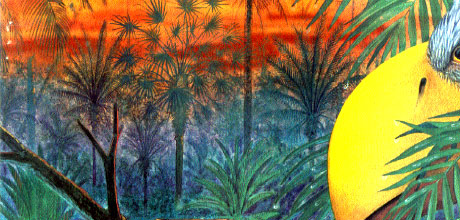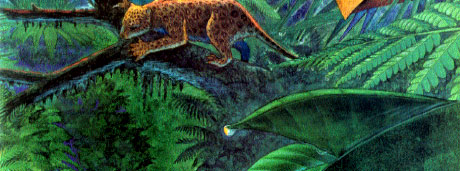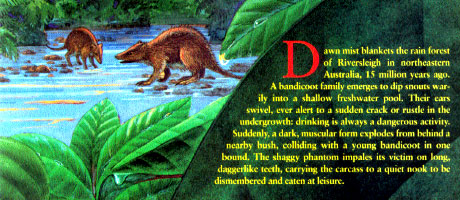
|
Search JoyZine with Google Site Search! |
Natural-Born Killers Mean Marsupials by Simon Benson reprinted from The Sunday Mail
Like a new-age messiah preaching evolutionary rationalism instead of Biblical scriptures, Mike Archer addresses his audience with an enthusiasm for his subject that borders on the evangelical. The palaeontologist and head of Sydney's Australian Museum stands high on the rocks where he first began his quest in what is now regarded as one of the world's richest fossil sites. "Something very strange went on here," Dr Archer says. "This place is now telling us things about Australia we didn't know." He is talking about the ancient limestone graves of Riversleigh, north-west Queensland, where he and his scientific disciples are convinced they have uncovered a lost world that only now is beginning to tell a fascinating story. Perfectly preserved remains of 15 million-year-old bats lie next to the remains of flesh-eating kangaroos, cow-sized wombats, marsupial lions and 300kg flightless birds. More than 300 previously unknown species have been unearthed from the rocks. Next to them are the fossils of plants and now, in the most extraordinary find, fossilised insects and bacteria; an entire rainforest ecosystem preserved under the red outback earth. Dr Archer says the site is imploring us to question Australia's evolution. Contrary to the popular notion that Australia's lost fauna was a "bunch of wussy plant eaters", Dr Archer says Riversleigh has proof that, in fact, they were dominated by a group of large, meat-eating mammals that chomped their way through the ancient landscape as the most ferocious carnivores of their time.Leading them was a group of super-predators known as thylocoleonids, some of which were as large and nasty as anything the mammal world has ever offered up. The difference was that they were marsupials; like kangaroos, they had a pouch. In a series of scientific papers they were dubbed by author Stephen Wroe as the Natural Born Killers. Their emergence from the largest fossil project in the world has sparked a major rethink about what went on in this strange land so many millennia ago. Although first discovered in 1900 by European naturalist E.W. Cameron, the miscalculation of rock age and the difficulty in extracting bone from the limestone meant Riversleigh was left largely untapped. But it is now known that Riversleigh dates back to about 26 million years (the Oligocene epoch) and not two million years. Its fossils span the entire last half of what is known as the age of the mammals (the Cenozoic Age) after the extinction of dinosaurs about 65 million years ago. "The reasons for this land of beasties lies with the separation of Australia between 38 and 45 million years ago," Dr Archer says. "Some time in that interval, Australia pulled away from the Gondwanaland mass of Antarctica and South America and took with it a group of creatures distinctly Gondwanan and put them in isolation for 30 million years. "It was during this period that everything wonderful began to happen at Riversleigh," he said. There was no doubt the theoretical knowledge base was there. The problem was getting the bones out. It was while experimenting with explosives to dislodge the bones that an exciting chance find was made. "The first time we used gelignite," Dr Archer said, "Henk headed for the hills to get away from the next explosion and discovered a rock he was sitting on was covered in bones, little bat bones. Before that, only one tooth was known in Australia." In 1983 the big mammalian discoveries started to come. "In one rock we found 34 new mammals and we added 60% to the knowledge of mammals in this country," Dr Archer says. In 1985, they discovered a flesh-eating kangaroo (Ekaltadeta ima) which lived from the Oligocene period (29 to 23 million years ago) until as late as 50,000 years ago. And "the marsupial lion was probably the most specialised carnivore in the world with huge incisor teeth, a massive meat-slicing tooth and a flick blade-like claw on each thumb. They had teeth that could cut the legs off kangaroos. They were as formidable as anything in the world and it is now apparent that, in fact, placental mammals were here—and got the stuffing kicked out of them by the marsupials." |


